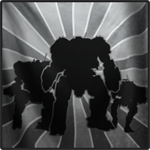Mechs as real life weapons have always been an interesting concept to me and I'm constantly doing research and brainstorming on what a practical mech would look like and whether or not they would be practical in the real world.
30 foot tall humanoid mechs are definitely out of the question. They're ridiculously over-complicated even by mech standards, the extra limbs would weigh them down, they have more joints than a chicken-walker style mech which means more weak points in the structure and basically the only thing they beat other mechs or armored vehicles at is looking awesome. (They do look pretty awesome, though.
According to everything I've been able to find, it seems to be that there are two possibilities for practical mechs: compact, highly mobile bipeds and heavily armored quad or six-legged crawlers.
The bipeds would be best suited for recon and infantry support in urban, jungle, forest, and mountain terrain, where their superior ability to navigate obstacles and cross difficult terrain would give them a significant advantage over a conventional tank of the same weight. With computer-controlled movement for high agility and a body smaller but slightly taller than a main battle tank, they could maneuver in ways that a tank never could, allowing them to gain a positional advantage on conventional opponents by more easily utilizing terrain features. Moderately armored and equipped with medium-caliber (40-50mm) guns and lightweight anti-tank weapons, a squad of these mechs could support advancing infantry by outmaneuvering and destroying enemy armored vehicles on urban or hilly terrain, in situations where air support isn't available. For combat in wide open areas they would carry Hellfire missiles or similar anti-armor weapons for engaging enemy tanks at standoff ranges with the help of a soldier using a laser designator, or their own sensors if need be. Basically, their function is somewhat of a cross between infantry power armor and a heavily armored attack helicopter.
The quads and six-leggers, on the other hand, would be the heavily armored, slow moving assault vehicles - essentially a tank with spider legs. With a greater number of legs to carry their weight and help spread out ground pressure, they could carry considerably heavier armor and armament then the biped types, likely on par with most MBTs. Their lower-slung design and wider stance would allow them to mount weapons such as 120mm guns like those found on tanks, allowing these mechs to stand up to tanks in a one-on-one fight, even though the mech would be considerably slower. These vehicles could be deployed in difficult terrain where tanks have a hard time moving around, such as mountain and urban areas like mentioned earlier. In these places, the legged crawler would be able to move to a higher vantage point, giving the crew the ability to set up ambushes for conventional tanks from areas that would otherwise be inaccessible.
Both types have the advantage of being able to peek over or around cover to fire at a target, while exposing as little of themselves as possible. The quad and six-legged mechs have the ability to raise and lower their stance, allowing them to pop up and fire over hills and cover from a hull-down position while exposing themselves for only a split second, whereas a tank must remain hull-down with its turret exposed to be able to fire. The bipedal mechs have both the ability to pop up from cover and to learn left and right to fire around corners, possibly using a flexible arm-like weapon mount to shoot around cover without exposing the vehicle itself.
Now to address some known counter-arguements:
Stability - Walking robots are getting better all the time, just look at Boston Dynamics' BigDog, Atlas, and WildCat. Soon we'll have walking robots with agility superior to humans; it won't be long before we know enough about these systems to construct them on a larger scale while maintaining that agility.
Ground Pressure - While it's true that a mech would sink into soft ground more easily than a tank, mechs have the ability to pull their feet out of the ground to take the next step, whereas if a tank becomes bogged down in the same terrain it is helpless until a tow vehicle arrives. Weight distribution could be maximized by using large snowshoe or skid-like feet that keep the mech from sinking up to its butt in very soft ground, such as marshes or swamps - places tanks tend to get stuck in anyway. Besides, 100-ton dinosaurs apparently got around on legs without any serious problems, or they would have never gotten as big as they were: http://dinosaurs.abo...t-Dinosaurs.htm
Recoil - Using multiple legs and a low, wide stance should allow mechs to fire high-caliber weaponry with few issues. For bipeds, the use of recoiless weapons such as energy weapons and missiles, or guns equipped with muzzle brakes and recoil mitigation technology such as a bigger version of the system used in the Kriss Vector submachine gun ( http://en.wikipedia....wiki/TDI_Vector ) could help minimize recoil issues.
Defense - Carbon nanotubes could be used to contruct mech armor, creating a material that is extremely light yet also virtually indestructible. This would provide mechs with extremely effective protection without increasing their weight so much that they lose their mobility advantage. To protect against missiles, the mech could be equipped with a TROPHY system or laser-based defense system that targets and destroys incoming projectiles before they hit the mech.
Fuel Efficiency - http://www.dvice.com...ntists_expl.php
Fuel efficency isn't a problem when you have an infinite power source. Once fusion technology is realized, it is only a matter of time before it is ruggedized and miniaturized for military use.
That's all I have for now.


























